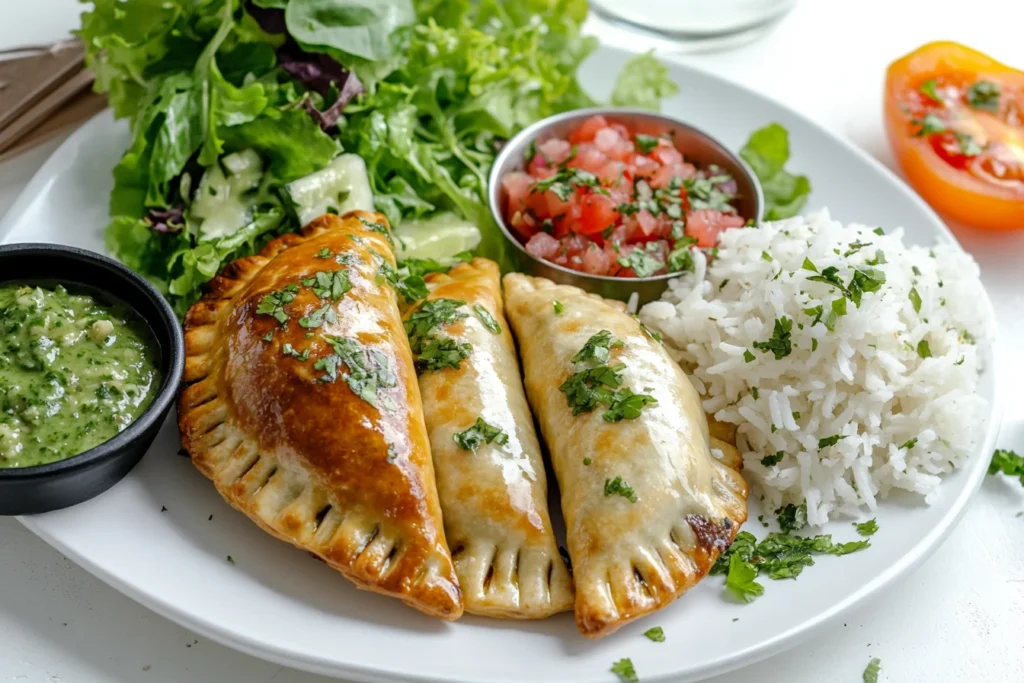Empanadas are pastry turnovers filled with various ingredients, typically savory meats, cheeses, or vegetables. Originating in Spain and popularized throughout Latin America, known for their crisp exterior and flavorful filling. Every region interprets empanadas differently, but the core concept remains consistent. These convenient pockets of flavor are often baked or fried, depending on preference and tradition. Since it adapt well to a wide range of fillings, they’ve become a favorite among home cooks seeking versatility. Whether served as a snack, appetizer, or main course, it delivers both texture and taste in every bite.

Table of Contents
Why This Recipe Is Perfect for Beginners
This recipe offers a straightforward, step-by-step process that makes it accessible to novice cooks. Even those without much kitchen experience can follow along confidently. Using either store-bought or homemade dough allows flexibility while keeping the steps manageable. Every phase of preparing empanadas—from dough to filling to sealing—is broken down clearly to reduce confusion. Because the ingredients are common and techniques are basic, beginners can focus on mastering each element.
Ingredients Breakdown
For the Dough
Creating dough for empanadas involves only a few basic ingredients: all-purpose flour, butter, salt, water, and sometimes egg. When prepared correctly, the dough should be soft, pliable, and slightly elastic. If you’re seeking efficiency, dough for empanadas can also be purchased pre-made. This speeds up preparation and ensures consistent results, especially for large batches. Homemade dough, on the other hand, allows for better control over flavor and texture. Both options produce delicious empanadas, but homemade versions often offer a richer, more tender bite.
Store-bought vs Homemade
- Store-bought dough:
- Convenient and time-saving.
- Uniform size and thickness.
- Ideal for quick empanadas prep.
- Homemade dough:
- Customizable flavor.
- Fresher texture.
- Requires more time and effort.
Choosing between the two depends on your schedule and confidence level, but either works well for empanadas.
For the Beef Filling

Best Ground Beef Options
Ground beef forms the heart of savory empanadas. For best results, choose beef with a moderate fat content, such as 80/20. This ratio ensures that the filling remains moist without becoming greasy. Leaner cuts may dry out during cooking, affecting the overall taste of the empanadas. Always cook the beef thoroughly, breaking it into small crumbles for even distribution. Browning the beef before combining it with other ingredients helps to lock in flavor.
Vegetables and Seasonings
To elevate the flavor of beef empanadas, blend finely chopped vegetables and seasonings into the meat mixture. Onions, garlic, and red bell peppers are traditional choices that complement beef well. Spices such as cumin, paprika, and oregano provide depth, while a touch of tomato paste adds moisture and richness. Including chopped olives introduces a briny counterpoint, balancing the savory notes. Carefully measured seasoning ensures the empanadas are flavorful without being overpowering.
Kitchen Tools You’ll Need
Preparing empanadas requires only a few basic tools:
- Skillet for browning beef.
- Mixing bowls for combining ingredients.
- Rolling pin (for homemade dough).
- Pastry cutter or knife.
- Fork or empanada press for sealing.
- Baking sheet with parchment paper.
These simple items make the process efficient and manageable.
Step-by-Step Instructions
Making the Dough (If Homemade)
To begin, combine flour and salt in a large bowl. Until the mixture resembles coarse crumbs, cut in cool butter. Add a beaten egg and a few tablespoons of cold water, mixing until the dough forms. Knead gently until smooth, then wrap and chill for 30 minutes. Chilled dough is easier to roll and results in crispier empanadas. Roll out the dough on a lightly floured surface and cut into circles using a round cutter or glass.
Preparing the Beef Filling
Heat the oil in a skillet over medium heat to begin. Add the ground beef and cook until browned, stirring often to break it apart. Drain excess fat before adding chopped onions, garlic, and bell pepper. Cook until vegetables are soft. Stir in tomato paste, cumin, paprika, and oregano, then simmer for 10 minutes. Once thickened, remove from heat and let the filling cool before using. This ensures the empanadas don’t become soggy during baking.
Assembling the Empanadas
Lay out your dough circles and place a spoonful of cooled filling in the center of each. To form the dough into a half-moon, fold it over. Gently press the edges together with your fingers. Overfilling can cause the empanadas to burst open during baking, so use moderate portions. Consistent sizing and careful folding help maintain structure and presentation.
Sealing Techniques
There are two common sealing methods for empanadas:
- Fork seal: Press the edges with a fork for a classic crimped appearance.
- Repulgue fold: Twist the edges over themselves in a braid-like pattern for a traditional finish.
Either method helps keep filling secure during cooking, preserving the integrity of the empanadas.
Baking vs Frying Options
- Baking: Preheat the oven to 375°F. Place empanadas on a parchment-lined tray and brush with egg wash. Bake for 20–25 minutes until golden brown.
- Frying: Heat oil to 350°F. Fry empanadas until crisp and golden, about 3–4 minutes per side. Drain on paper towels.
Both methods yield delicious results, though baking offers a lighter texture.
Tips and Tricks for Perfect Empanadas
Avoiding a Soggy Bottom
To avoid soggy empanadas, ensure the filling is cool and not overly wet. Excess moisture seeps into the dough, ruining the texture. Simmer the beef mixture until thick and allow it to cool completely before assembling.
Keeping the Filling Juicy but Not Wet
Balancing moisture is essential. Use ingredients like tomato paste or a splash of broth to keep beef empanadas moist. However, monitor the consistency to prevent sogginess. Stirring in a small amount of breadcrumbs can help absorb excess liquid.
Variations to Try

Cheese and Beef Combo
For a rich flavor, add shredded mozzarella or cheddar to the beef filling. Cheese enhances texture and adds creaminess without overwhelming the meat flavor.
Spicy Beef
Incorporate jalapeños, cayenne pepper, or hot sauce for spicy empanadas. Adjust heat levels to suit your preference, ensuring a flavorful kick without overpowering the dish.
Sweet and Savory Twist
Add a handful of raisins or chopped dates to contrast the savory beef. This sweet-savory version of empanadas creates a unique, well-balanced flavor profile.
Storage and Reheating Instructions
Cooked empanadas can be kept in the fridge for up to four days in an airtight container. For longer storage, freeze them on a baking sheet, then transfer to freezer bags. Reheat empanadas in a 350°F oven for 10–15 minutes, ensuring they remain crisp. Avoid microwaving, as it softens the crust.
What to Serve With Beef Empanadas

Pairs well with a variety of sides and sauces:
- Chimichurri for herbal brightness.
- Salsa verde or red sauce for zest.
- Rice and beans for a complete meal.
- Simple green salad to balance richness.
Choose accompaniments based on the occasion and your personal taste.
For more dinner ideas, check out our Delicious Steak Bowl.
Common Mistakes to Avoid
- Overfilling causes leakage.
- Using hot filling leads to soggy dough.
- Forgetting the egg wash prevents proper browning.
- Skipping sealing steps risks filling loss during baking or frying.
Being mindful during each step improves your final result.
Healthier Alternatives
For a lighter alternative, opt for:
- Ground turkey or chicken instead of beef.
- Whole wheat flour for fiber-rich dough.
- Baking rather than frying to reduce oil intake.
- Including more vegetables to increase nutrition.
These adjustments maintain flavor while improving health benefits.
Conclusion
Making empanadas at home can be both rewarding and practical. This easy recipe simplifies the process, guiding you through each phase with clarity. Whether you bake or fry them, stuff them with beef alone or try a variation, the result is a dish that offers both flavor and flexibility. Mastering the basics of empanadas gives you a foundation to explore further combinations while enjoying a traditional favorite.
FAQ
Can I freeze beef empanadas?
Yes! Freeze before or after baking. Just reheat in the oven — no thawing needed.
What dough can I use instead of traditional empanada dough?
Puff pastry or even pie crust works great in a pinch.
How long do they last in the fridge?
3 to 4 days in an airtight container.
